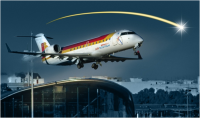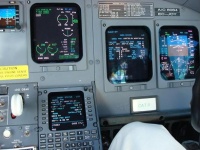If you wish to contribute or participate in the discussions about articles you are invited to contact the Editor
EGNOS Safety of Life Service: Difference between revisions
(Intermediate) |
(Intermediate) |
||
| Line 26: | Line 26: | ||
On the 2nd March 2011, the European Satellite Services Provider (ESSP)<ref name="ESSP">[http://www.essp-sas.eu European Satellite Services Provider]</ref> declared<ref name="ESSP Press Release">[http://www.essp-sas.eu/downloads/xwpoqsqqtp/pr_sol_d_march2_en.pdf EGNOS Safety of Life Service Start Official declaration]</ref> the Safety-of-Life (SoL) signal officially available for aviation with the authorization of the European Commission (EC) to provide the service. At this point message type 0 (MT0) that used to transmit the same contents as a regular MT2 message before certification of EGNOS for civil aviation was removed. | On the 2nd March 2011, the European Satellite Services Provider (ESSP)<ref name="ESSP">[http://www.essp-sas.eu European Satellite Services Provider]</ref> declared<ref name="ESSP Press Release">[http://www.essp-sas.eu/downloads/xwpoqsqqtp/pr_sol_d_march2_en.pdf EGNOS Safety of Life Service Start Official declaration]</ref> the Safety-of-Life (SoL) signal officially available for aviation with the authorization of the European Commission (EC) to provide the service. At this point message type 0 (MT0) that used to transmit the same contents as a regular MT2 message before certification of EGNOS for civil aviation was removed. | ||
[[File:EGNOS_equipped_Aircraft.jpg|EGNOS-equipped cockpit|200px|thumb|right]] | |||
The aviation user, as mentioned in the [[Terms and Conditions|Terms and Conditions]] definition, is subjected to the specific Working Agreements between ESSP and Air Navigation Service Providers (ANSPs) as stated by the EC Single European Sky regulation.<ref name=" EC Single European Sky regulation ">[http://www.eurocontrol.int/prc/gallery/content/public/Docs/Regulation_549_2004_consolidated.pdf Regulation (EC) No 549/2004 of the European Parliament and of the Council of 10 March 2004 laying down the framework for the creation of the single European sky]</ref> | |||
==Safety of Life Requirements== | ==Safety of Life Requirements== | ||
Revision as of 21:15, 31 March 2011
| EGNOS | |
|---|---|
| Title | EGNOS Safety of Life Service |
| Author(s) | GMV. |
| Level | Basic |
| Year of Publication | 2011 |
The EGNOS Safety of Life Service (SoL) consists of an augmentation signal to the Global Positioning System (GPS) Standard Positioning Service (SPS) intended for most transport safety critical applications. The target application domains are, thus, aviation, maritime, railway and road where degradation in the navigation system performance without a notice within the specified time to alert would endanger lives.
Terms and Conditions
The Safety of Life Service is accessible to any user equipped with an EGNOS certified receiver and located within the appropriate EGNOS SoL Service area.
However, navigation operations based on the EGNOS SoL Service require authorization issued by the relevant authority as long as the specific authority or applicable regulation states that no such authorization is required. This authorization, as defined in EGNOS Mission Requirements Document[1], is subjected to specified operational conditions and limitations, existence of published navigation procedure and to the certification of the on board navigation equipment.
Consequently, an aircraft or operator will need to be subscriber of the required Service Level Agreement in order to get a service guarantee from the EGNOS Service Provider on the EGNOS Safety of Life Service. In addition, the service guarantee will only be applicable within the Safety of Life Service area.
EGNOS SoL for Aviation
The SoL Service is intended to support a wide range of transport domains. Nevertheless, the main objective of the EGNOS SoL service is to support civil aviation operations down to Localizer Performance with Vertical guidance (LPV). This means that the service is compliant with aviation Approach with Vertical Guidance (APV-I) requirements defined in the ICAO Standard and Recommended Practices (SARPs) for SBAS[2] as expressed in EGNOS Safety of Life Service Definition Document.[3]
At the date of this publication, only the aviation domain has specific service requirements, as well as certification and individual authorization procedures developed and implemented.
On the 2nd March 2011, the European Satellite Services Provider (ESSP)[4] declared[5] the Safety-of-Life (SoL) signal officially available for aviation with the authorization of the European Commission (EC) to provide the service. At this point message type 0 (MT0) that used to transmit the same contents as a regular MT2 message before certification of EGNOS for civil aviation was removed.
The aviation user, as mentioned in the Terms and Conditions definition, is subjected to the specific Working Agreements between ESSP and Air Navigation Service Providers (ANSPs) as stated by the EC Single European Sky regulation.[6]
Safety of Life Requirements
Benefits for Civil Aviation
Notes
References
- ^ EGNOS Mission Requirements Document, version 2.0, 8th May 2006, Galileo Joint Undertaking
- ^ Minimum Operational Performance Standards for Global Positioning System/Wide Area Augmentation System Airbone Equipment
- ^ EGNOS Safety of Life Service Definition Document
- ^ European Satellite Services Provider
- ^ EGNOS Safety of Life Service Start Official declaration
- ^ Regulation (EC) No 549/2004 of the European Parliament and of the Council of 10 March 2004 laying down the framework for the creation of the single European sky


